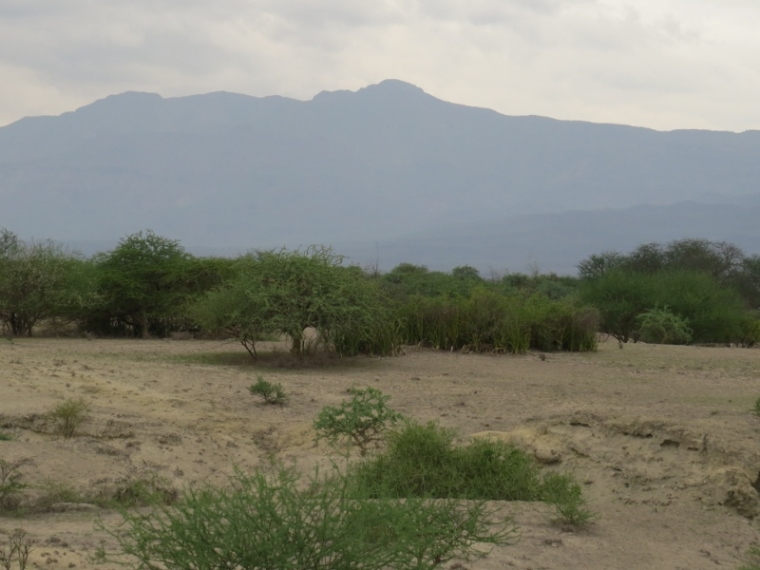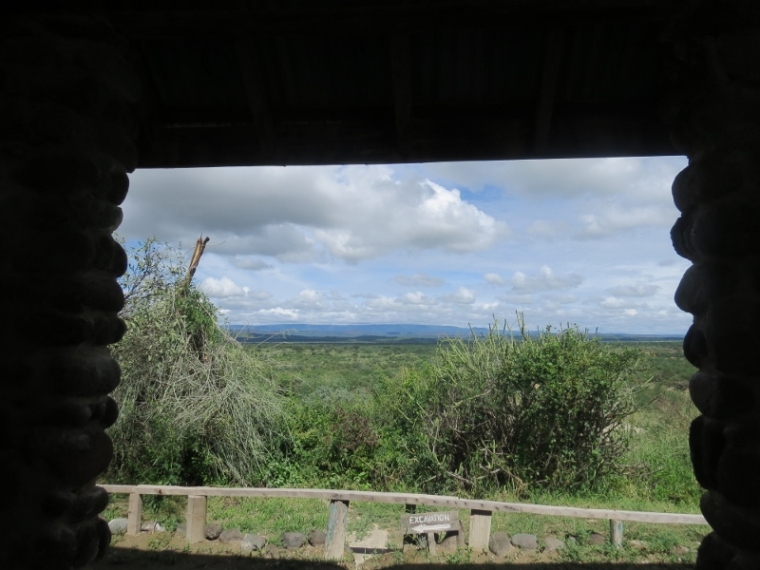The fascinating metropolis of ancient ancestors
Above: Mt Olorgesailie decked in cloud and wild flowers – copyright Rupi Mangat 5 May 2018
Published: Saturday magazine Nation newspaper 5 May 2018

I’m alone walking between two ancient volcanoes on sands that have weathered the times and bleached white by the relentless sun with volcanic rubble strewn around. Tiny white flowers and petals of yellow on skeletal green stalks that otherwise are so brittle during the dry season carpet the ground.
I’m at Olorgesailie, home of our ancestors, the upright human or Homo erectus who walked out of Africa and into the bigger world a million years ago.
In my aloneness my mind begins to wander.

Was there a woman like me who strolled the same earth that l am on to stop and marvel at the wild flowers and pick at the flame-red wild lily? Did she stand on the high vantage point like me to take in the enormity of the landscape – the copper red cliffs and the ridge lining the western horizon from where the moon rises?
And did she climb down to take shelter under the canopy of the slow growing commiphora to watch the hunt taking place?

A few steps away l’m looking at the fossilized femur of the Elephus recki – a gigantic elephant that walked the land for three million years and then vanished 660,000 years ago. Around the fossilized thigh bone of this elephant that was more related to the Asian elephant lie tools that were fabricated by our human ancestor, Homo erectus. These are the famous stone tools of Olorgesailie.
Theories abound. One is that the elephant could have been butchered here – hold your breath – 992,000 years ago. At this point, from 1.2 million years ago, Homo erectus was a savvy tool maker manufacturing sharp-edged stone hand-axes to slice through the flesh of an animal.
The kilometre-long walk along the ancient soils of Olorgesailie has me pass the millennia-old hippo fossil and more stone tools found in-situ.
It’s a slow stroll – l’m in no hurry even though it’s midday. At most times the site lying on the floor of the Rift Valley has temperatures soaring up to 40 degrees centigrade making all seek shade.

But it’s the season of the long rains and we’re seeing something that most of us have never seen around Olorgesailie – water. Driving in form Nairobi, the rivers are in full spate – rivers that are always scorched riverbeds. There’s stone rubble from the landslides on the road and skies laden with clouds atop the Ngong Hills, capping the volcanoes of Esakut and Olorgesailie. Lake Kwenia and another water pool lie on either side of Olorgesaili – again something we have never seen before.

“I’ve never seen this river so high,” exclaims Fleur Ng’weno of Nature Kenya. “The rains this year in Kenya have been heavy and scattered unlike the normal rains that are long and steady.” It’s part of climate change, she reasons.
Up in these vast skies, fly the mighty raptors –Verraux’s eagle and the African hawk eagle. “We come here to see these raptors,” tells Sydney Shema a keen birder. He’s interrupted by Jennifer Odouri, “The Verraux’s eagle is my favourite. You see it once and you can never forget it.”
By now l’m inside the simple little museum that has such a wealth of human history. It shows the hand axes that date between 1.2 million years to 500,000 years. With time the Homo got smarter to make sophisticated one-strike flakes from 500,000 years to 100,000 years ago heralding in the Middle stone age.
Olorgesailie is super-intriguing. According to Dr Rick Potts of the Smithsonian Institute who has been studying the site for more than twenty years, these rocks weren’t found locally but some 150 kilometres away meaning that the ‘upright human’ was trading even then.

At this point my attention is diverted to a glass cage with two non-descript fragments in it. Reading the board, they are two fragments of the cranium (skull) – the very first human fossil discovered at Olorgesailie. Dated at 900,000 years ago, they were identified in 2003 when Christopher Kilonzi of the National Museums of Kenya cleaned the sediment rock that was excavated in 1999 and later in 2003 by the team headed by Dr Potts from the Smithsonian Institute and NMK.

There’s still more coming out of Olorgesailie – watch this space!
All about Olorgesailie Prehistoric Site www.museums.or.ke
Join Nature Kenya for exciting hikes naturekenya.org
Olorgesailie is the best dated prehistoric site in the world from around 1.2 million years ago – the age of the Homo erectus.
In 1947, the first African Archaeology Congress was held at which time the gang walk around the stone tool sites was built.
It’s 90 kms south of Nairobi. You can camp or book a banda. Carry food and water




